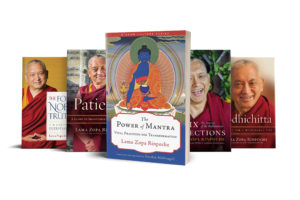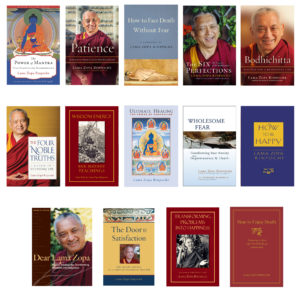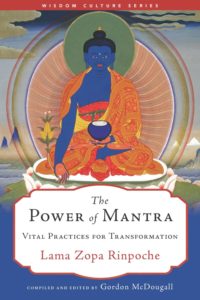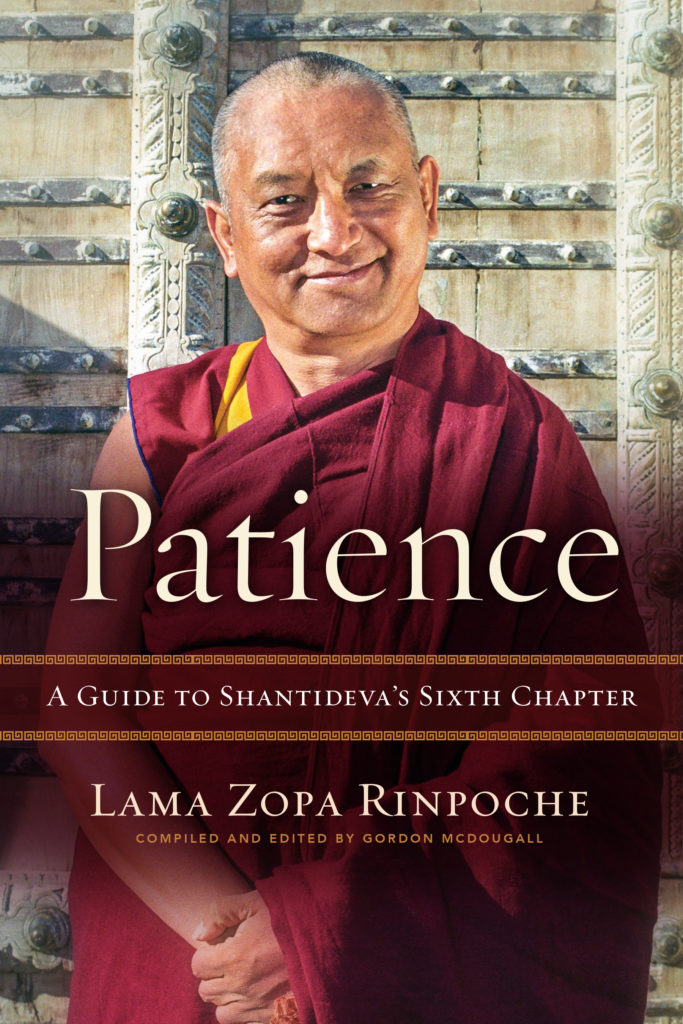“Shantideva was like us, but he worked on his mind until he became completely free from delusions . . . A Guide to the Bodhisattva’s Way of Life has inspired countless people since it was written over thirteen hundred years ago. It tells us that we too can develop our mind to the levels of realizations that the great masters have attained—and it shows us how to do it.”
—Lama Zopa Rinpoche, Patience

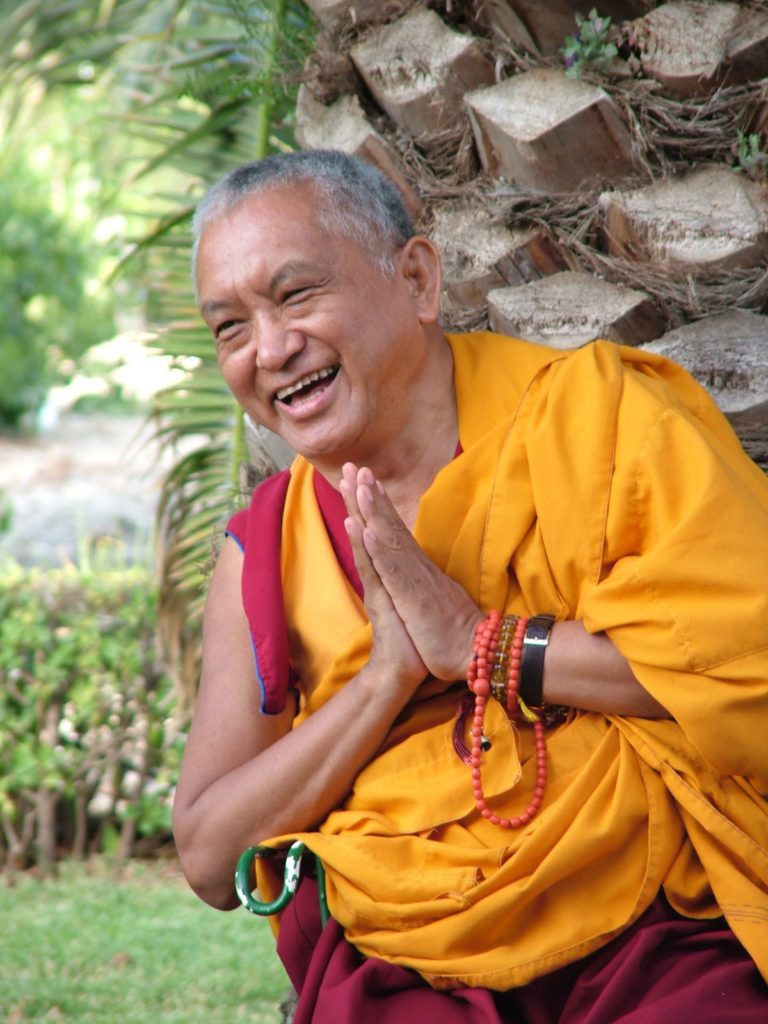
Lama Zopa Rinpoche was one of the most internationally renowned masters of Tibetan Buddhism, working and teaching ceaselessly on almost every continent. He was the spiritual director and cofounder of the Foundation for the Preservation of the Mahayana Tradition (FPMT), an international network of Buddhist projects, including monasteries in six countries and meditation centers in over thirty; health and nutrition clinics, and clinics specializing in the treatment of leprosy and polio; as well as hospices, schools, publishing activities, and prison outreach projects worldwide.
Born in the Mount Everest region of Thami in 1946, Rinpoche was recognized soon afterwards by His Holiness Trulshik Rinpoche and five other lamas as the reincarnation of the great yogi Kunsang Yeshe. Rinpoche was taken under the care of FPMT’s founder Lama Thubten Yeshe, soon after leaving Tibet, in Buxa Duar, India, in the early 1960’s. Rinpoche was with Lama Yeshe until 1984 when Lama Yeshe passed away and Lama Zopa Rinpoche took over as spiritual director of FPMT.
“The most happy thing in my life, most fulfilling thing is to work for and to benefit sentient beings. Even just the mere thought to cause happiness to sentient beings, to benefit them, to free them from suffering is the BEST offering to all the buddhas and bodhisattvas. This is the best offering, the best puja; this is what pleases their holy mind most.”—Lama Zopa Rinpoche

| The Power of Mantra: Vital Practices for Transformation
A mantra—literally “that which protects the mind”—is a series of Sanskrit syllables that evoke the energy of a particular buddha or bodhisattva. It works as a sacred sound that brings blessings to ourself and others, and as a tool to transform our mind into one that is more compassionate and wise. In clear and succinct teachings, Lama Zopa shows us why we need different mantras and how each mantra works. He also explains their importance and power, giving specific instructions for practicing them. The exquisite, full-color illustrations of the deities that accompany the text make this book a beautiful guide, one suitable for both beginners and experienced practitioners. In clear and succinct teachings, Lama Zopa shows us why we need different mantras and how each mantra works. He also explains their importance and power, giving specific instructions for practicing them. The exquisite, full-color illustrations of the deities that accompany the text make this book a beautiful guide, one suitable for both beginners and experienced practitioners.
Patience: A Guide to Shantideva’s Sixth Chapter
In explaining this quintessential quality of a bodhisattva, Rinpoche shows us ordinary beings the profundity of the practice of patience and the relevance it has in our everyday lives. “Shantideva was like us, but he worked on his mind until he became completely free from delusions . . . A Guide to the Bodhisattva’s Way of Life has inspired countless people since it was written over thirteen hundred years ago. It tells us that we too can develop our mind to the levels of realizations that the great masters have attained—and it shows us how to do it.”—Lama Zopa Rinpoche |
|
|
How to Face Death Without Fear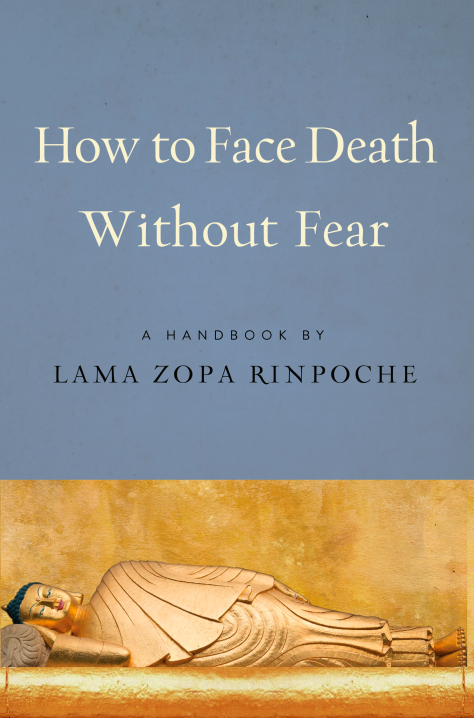 “Helping our loved ones at the time of death is the best service we can offer them, our greatest gift. Why? Because death is the most important time of life: it’s at death that the next rebirth is determined.”—Lama Zopa RinpocheFor years Lama Zopa Rinpoche envisioned a practical book to inform students of how to help loved ones have a beneficial death. How to Face Death without Fear has been compiled from years of Rinpoche’s teachings and has been lovingly edited by Venerable Robina Courtin.Rinpoche provides detailed advice on how to help your loved ones prepare for the end of their life with courage, acceptance, and a mind free of fear. With great care, he explains what to do in the months, weeks, and days before death, how to handle the moment itself, what to do after the breath has stopped, and finally, what to do after the mind has left the body. Rinpoche provides the mantras, prayers, and meditations appropriate for each stage. This new edition of Rinpoche’s modern classic How to Enjoy Death makes it easy for the reader to find the right practice at the right time.This handbook is an essential reference for Tibetan Buddhist caregivers, hospice workers, and chaplains. But, as Rinpoche points out, it is not only for people who work with the dying; it is education we all need.You’ll find solace in this wealth of advice, and you’ll also gain the confidence to ensure that your loved one’s death—and your own—will be joyful and meaningful. “Helping our loved ones at the time of death is the best service we can offer them, our greatest gift. Why? Because death is the most important time of life: it’s at death that the next rebirth is determined.”—Lama Zopa RinpocheFor years Lama Zopa Rinpoche envisioned a practical book to inform students of how to help loved ones have a beneficial death. How to Face Death without Fear has been compiled from years of Rinpoche’s teachings and has been lovingly edited by Venerable Robina Courtin.Rinpoche provides detailed advice on how to help your loved ones prepare for the end of their life with courage, acceptance, and a mind free of fear. With great care, he explains what to do in the months, weeks, and days before death, how to handle the moment itself, what to do after the breath has stopped, and finally, what to do after the mind has left the body. Rinpoche provides the mantras, prayers, and meditations appropriate for each stage. This new edition of Rinpoche’s modern classic How to Enjoy Death makes it easy for the reader to find the right practice at the right time.This handbook is an essential reference for Tibetan Buddhist caregivers, hospice workers, and chaplains. But, as Rinpoche points out, it is not only for people who work with the dying; it is education we all need.You’ll find solace in this wealth of advice, and you’ll also gain the confidence to ensure that your loved one’s death—and your own—will be joyful and meaningful.
|
|
|
The Six Perfections: The Practice of the Bodhisattvas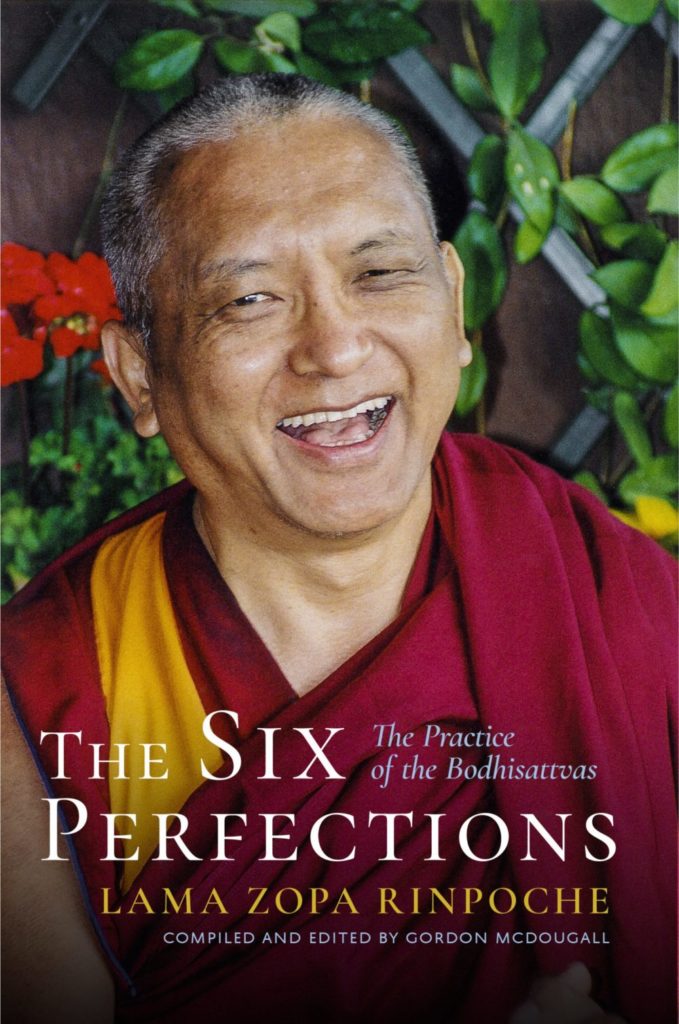 The six perfections are the actions of the bodhisattvas—holy beings who have transcended selfless concerns. But they’re also skills we can and should develop right now, in our messy, ordinary lives.In this clear, comprehensive guide to the backbone of Mahayana Buddhist practice, Lama Zopa Rinpoche walks us through each of the six perfections: Charity; Morality; Patience; Perseverance; Concentration; and Wisdom. As he carefully describes each perfection, he not only reveals the depth of its meaning and how it intertwines with each other perfection, but he also explains how to practice it fully in our everyday lives—offering concrete ways for us to be more generous, more patient, more wise. With the guidance he gives us, we can progress in our practice of the perfections until we, like the bodhisattvas, learn to cherish others above ourselves.“The perfections are the practices of bodhisattvas, holy beings who have completely renounced the self; they have transcended selfish concerns and cherish only others. Each perfection is perfect, flawless. Each arises from bodhichitta and is supported by the other perfections, including the wisdom of emptiness. Because of that, a bodhisattva generates infinite merit every moment, whether outwardly engaged in working for others or not. A bodhisattva’s bodhichitta never stops.”—Lama Zopa Rinpoche The six perfections are the actions of the bodhisattvas—holy beings who have transcended selfless concerns. But they’re also skills we can and should develop right now, in our messy, ordinary lives.In this clear, comprehensive guide to the backbone of Mahayana Buddhist practice, Lama Zopa Rinpoche walks us through each of the six perfections: Charity; Morality; Patience; Perseverance; Concentration; and Wisdom. As he carefully describes each perfection, he not only reveals the depth of its meaning and how it intertwines with each other perfection, but he also explains how to practice it fully in our everyday lives—offering concrete ways for us to be more generous, more patient, more wise. With the guidance he gives us, we can progress in our practice of the perfections until we, like the bodhisattvas, learn to cherish others above ourselves.“The perfections are the practices of bodhisattvas, holy beings who have completely renounced the self; they have transcended selfish concerns and cherish only others. Each perfection is perfect, flawless. Each arises from bodhichitta and is supported by the other perfections, including the wisdom of emptiness. Because of that, a bodhisattva generates infinite merit every moment, whether outwardly engaged in working for others or not. A bodhisattva’s bodhichitta never stops.”—Lama Zopa Rinpoche
|
|
|
Bodhichitta: Practice for a Meaningful Life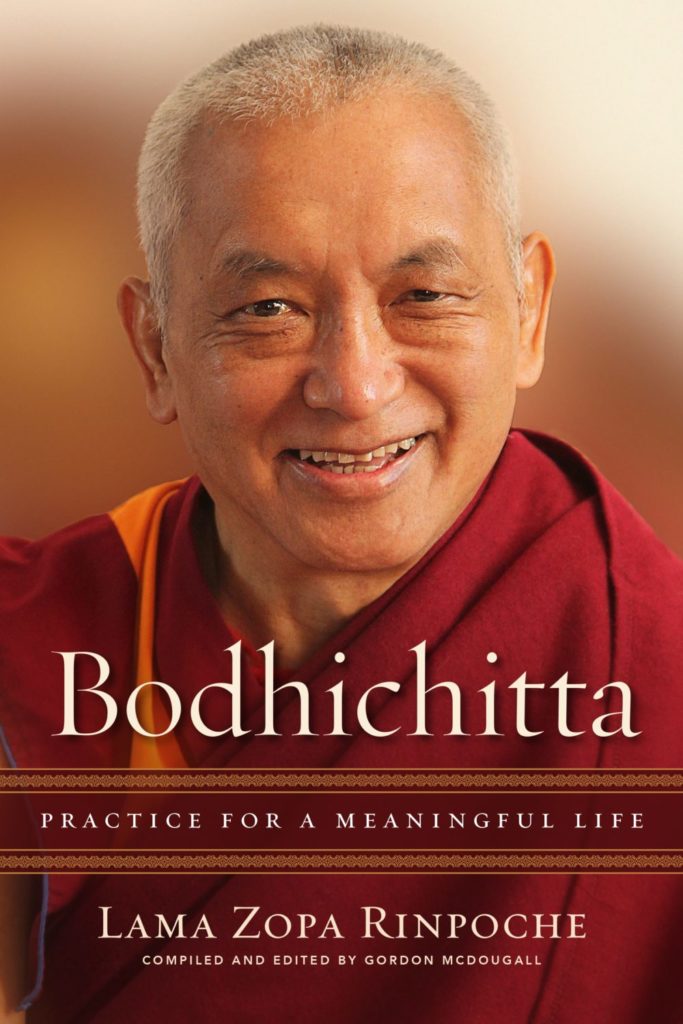 An accessible, inspiring book on one of the most important topics in Tibetan Buddhism, written by one of its renowned masters who has an international following of thousands.Bodhichitta is a Sanskrit word meaning “the mind of enlightenment” or “the awakening mind”—the mind that wishes to achieve enlightenment in order to lead all other beings into that same state. It is the attitude of the bodhisattva, of the person who makes the compassionate vow to save others from suffering. In this book, the renowned teacher Lama Zopa Rinpoche shows us how to achieve it.First, Lama Zopa gives a clear and comprehensive explanation of bodhichitta, its benefits, and its importance to the path. Then, he walks us through the two main methods for achieving bodhichitta: the seven points of cause and effect, and equalizing and exchanging self and others. Finally, the book closes with meditation instructions to guide and strengthen our practice.Readers will find Bodhichitta to be a comprehensive guide to this core Buddhist principle, one rich in both accessible philosophical explanation and concrete advice for practitioners. An accessible, inspiring book on one of the most important topics in Tibetan Buddhism, written by one of its renowned masters who has an international following of thousands.Bodhichitta is a Sanskrit word meaning “the mind of enlightenment” or “the awakening mind”—the mind that wishes to achieve enlightenment in order to lead all other beings into that same state. It is the attitude of the bodhisattva, of the person who makes the compassionate vow to save others from suffering. In this book, the renowned teacher Lama Zopa Rinpoche shows us how to achieve it.First, Lama Zopa gives a clear and comprehensive explanation of bodhichitta, its benefits, and its importance to the path. Then, he walks us through the two main methods for achieving bodhichitta: the seven points of cause and effect, and equalizing and exchanging self and others. Finally, the book closes with meditation instructions to guide and strengthen our practice.Readers will find Bodhichitta to be a comprehensive guide to this core Buddhist principle, one rich in both accessible philosophical explanation and concrete advice for practitioners.
|
|
|
The Four Noble Truths: A Guide to Everyday Life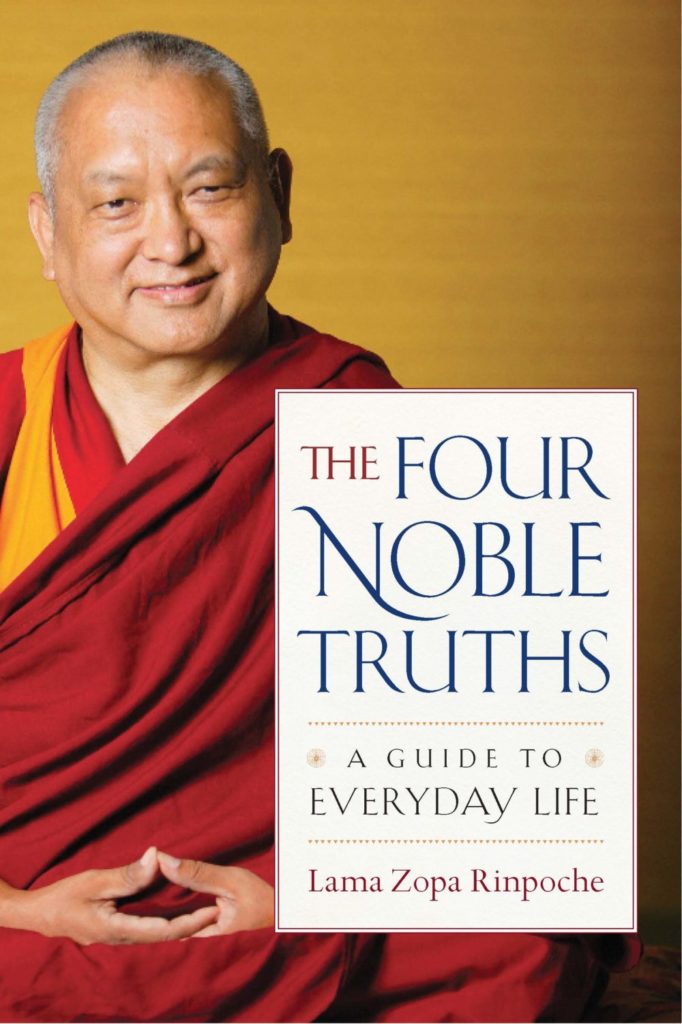 The Four Noble Truths begins with an excellent elucidation of the nature of the mind and its role in creating the happiness we all seek. Lama Zopa Rinpoche then turns to an in-depth analysis of the four truths. The first truth is that we are suffering because we are in cyclic existence, or samsara, the beginningless cycle of death and rebirth characterized by three types of suffering: the suffering of suffering, the suffering of change, and pervasive compounding suffering. These are not inflicted on us without cause, nor do they come from others. The second truth tells us that there is a cause for all this suffering—the delusions and karma that arise from the ignorance that fails to see the way in which things exist. Because there is a cause and because we can develop the wisdom realizing emptiness, the antidote to ignorance, we are able to actualize the third truth, the cessation of suffering. How we do that is explained in the fourth truth, the path to the cessation of suffering. The Four Noble Truths begins with an excellent elucidation of the nature of the mind and its role in creating the happiness we all seek. Lama Zopa Rinpoche then turns to an in-depth analysis of the four truths. The first truth is that we are suffering because we are in cyclic existence, or samsara, the beginningless cycle of death and rebirth characterized by three types of suffering: the suffering of suffering, the suffering of change, and pervasive compounding suffering. These are not inflicted on us without cause, nor do they come from others. The second truth tells us that there is a cause for all this suffering—the delusions and karma that arise from the ignorance that fails to see the way in which things exist. Because there is a cause and because we can develop the wisdom realizing emptiness, the antidote to ignorance, we are able to actualize the third truth, the cessation of suffering. How we do that is explained in the fourth truth, the path to the cessation of suffering. |
|
|
Wisdom Energy: Basic Buddhist Teachings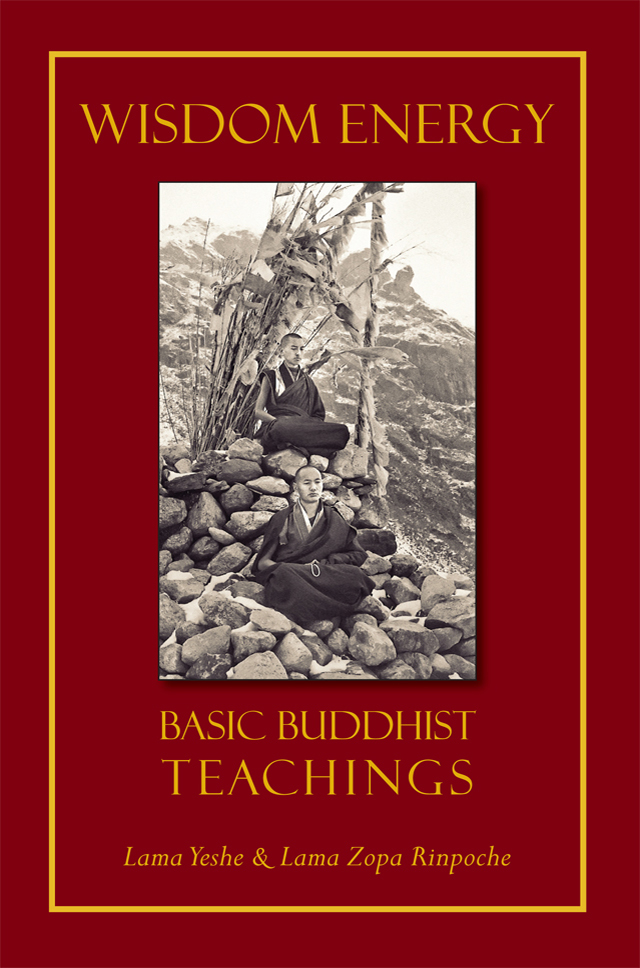 By Lama Yeshe & Lama Zopa RinpocheWisdom Energy is a simple and compelling introduction to Buddhism by two Tibetan lamas renowned for their insight and skill in teaching Westerners. Containing an entire meditation course, it goes to the heart of basic Buddhist practice and discusses the meaning and purpose of meditation, the causes of dissatisfaction and unhappiness, and the methods for subduing them and gaining control over our minds and lives. Originally published in 1976, Wisdom Energy still preserves the power, humor, and directness of the lamas’s first teaching tour of North America, giving the reader the feeling of an intimate audience with two highly respected teachers. By Lama Yeshe & Lama Zopa RinpocheWisdom Energy is a simple and compelling introduction to Buddhism by two Tibetan lamas renowned for their insight and skill in teaching Westerners. Containing an entire meditation course, it goes to the heart of basic Buddhist practice and discusses the meaning and purpose of meditation, the causes of dissatisfaction and unhappiness, and the methods for subduing them and gaining control over our minds and lives. Originally published in 1976, Wisdom Energy still preserves the power, humor, and directness of the lamas’s first teaching tour of North America, giving the reader the feeling of an intimate audience with two highly respected teachers.
|
|
|
Ultimate Healing: The Power of Compassion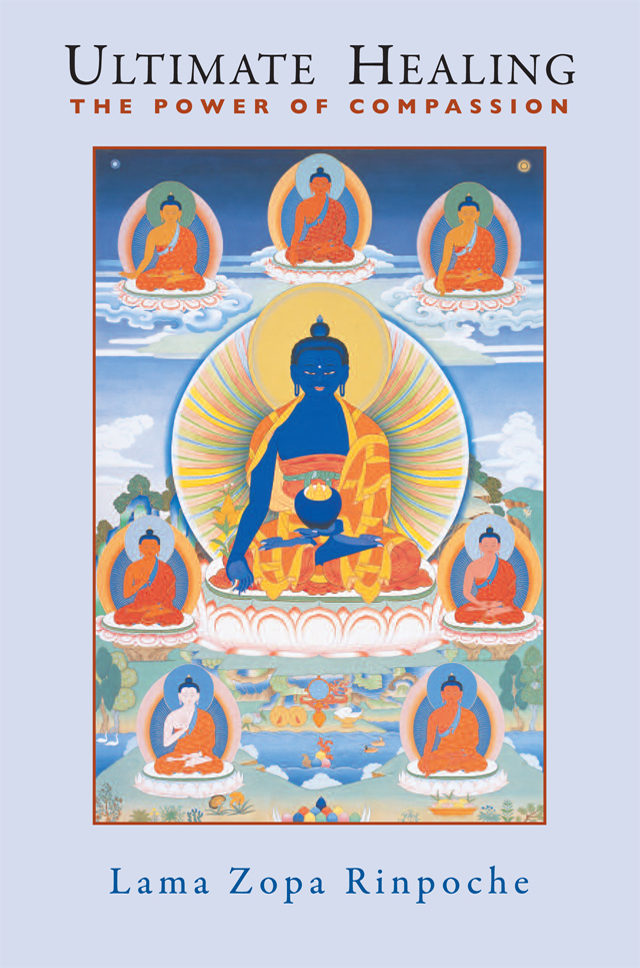 We experience illness on a physical level, but in order to be healed, we must understand where true healing begins: within our hearts and minds. In Ultimate Healing, internationally renowned meditation master Lama Zopa Rinpoche helps us to recognize the root of illness and gives us the tools to create our future happiness. Beginning with stories of people who have recovered from disease through meditation, Rinpoche addresses the central role played by karma and by the mental habit of “labeling” in causing illness, and shows how meditation and other thought techniques for developing compassion and insight can eliminate the ultimate cause of all disease.Ultimate Healing shows us that by transforming our minds, especially through the development of compassion, we can eliminate the ultimate cause of all disease. In addition to relating stories of people who have recovered from disease through meditation, Lama Zopa presents practical healing meditations, including white-light healing, compassion meditation, “taking and giving”, and techniques to cure depression. We experience illness on a physical level, but in order to be healed, we must understand where true healing begins: within our hearts and minds. In Ultimate Healing, internationally renowned meditation master Lama Zopa Rinpoche helps us to recognize the root of illness and gives us the tools to create our future happiness. Beginning with stories of people who have recovered from disease through meditation, Rinpoche addresses the central role played by karma and by the mental habit of “labeling” in causing illness, and shows how meditation and other thought techniques for developing compassion and insight can eliminate the ultimate cause of all disease.Ultimate Healing shows us that by transforming our minds, especially through the development of compassion, we can eliminate the ultimate cause of all disease. In addition to relating stories of people who have recovered from disease through meditation, Lama Zopa presents practical healing meditations, including white-light healing, compassion meditation, “taking and giving”, and techniques to cure depression.
|
|
|
Wholesome Fear: Transforming Your Anxiety About Impermanence and Death 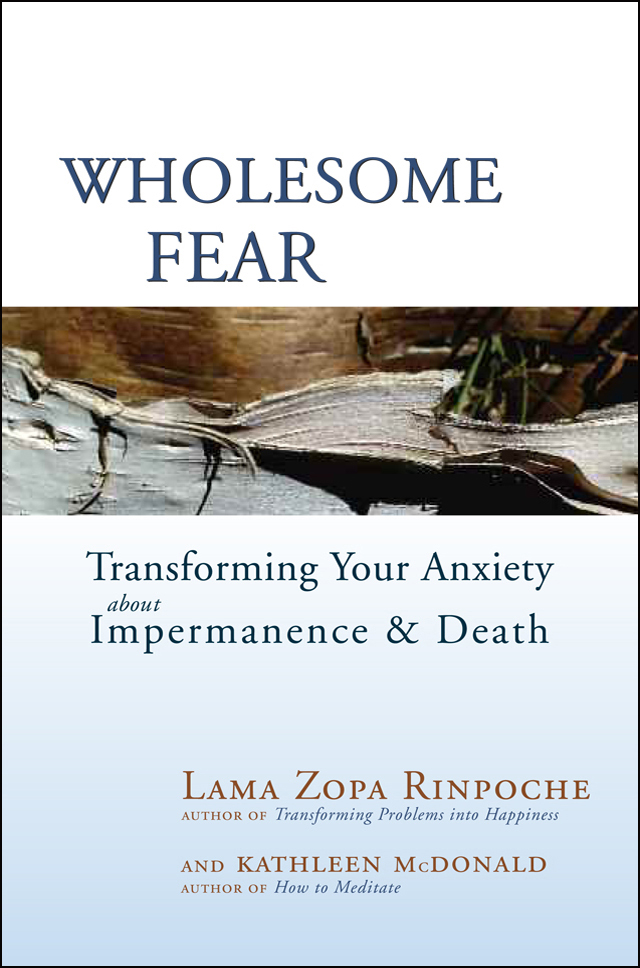 With the right perspective, our anxiety around sickness, old age, and death can be a “wholesome fear”—a fear with a positive quality that ultimately enriches and nourishes our lives. Lama Zopa Rinpoche shows us how we can use our anxiety as a high-octane fuel to really live what’s most important. Alongside Rinpoche’s teachings, Kathleen McDonald presents meditations that lead to peace, compassion, and joy for ourselves and others. Approaching our physical realities in this way will help us to live well and, when the time comes as it inevitably will, to die well too. It’s never too early to start making this most important of efforts—and, fortunately, it is never too late. An essential guide for anyone confronting the challenges of death and dying, Wholesome Fear serves as a reminder of the gift and truth of impermanence. With the right perspective, our anxiety around sickness, old age, and death can be a “wholesome fear”—a fear with a positive quality that ultimately enriches and nourishes our lives. Lama Zopa Rinpoche shows us how we can use our anxiety as a high-octane fuel to really live what’s most important. Alongside Rinpoche’s teachings, Kathleen McDonald presents meditations that lead to peace, compassion, and joy for ourselves and others. Approaching our physical realities in this way will help us to live well and, when the time comes as it inevitably will, to die well too. It’s never too early to start making this most important of efforts—and, fortunately, it is never too late. An essential guide for anyone confronting the challenges of death and dying, Wholesome Fear serves as a reminder of the gift and truth of impermanence.
|
|
|
How to be Happy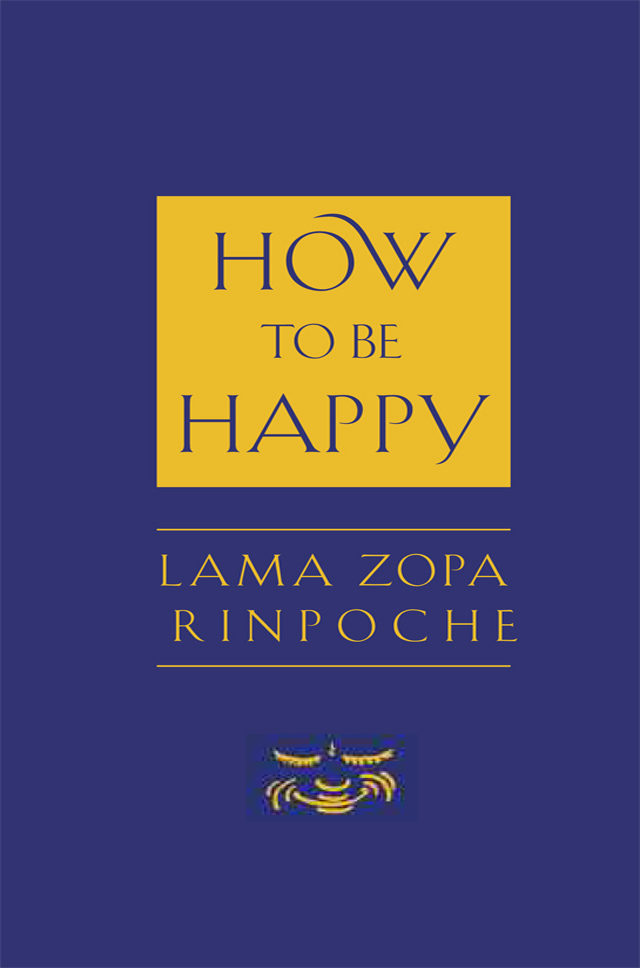 In How to Be Happy, Lama Zopa Rinpoche helps us find our good heart, the heart that rejoices in the happiness of others. How to transform problems into happiness, how to find compassion for our “enemies”, how to treat ourselves with kindness; it is on these persistent and universal challenges that Lama Zopa offers his wise and warm teachings. Including three wonderfully rich and evocative guided meditations, How to Be Happy works with the reader to show that happiness in this present moment is dependent on the wisdom of a truly open and generous heart.Anyone looking for advice on how to be happy—truly, meaningfully happy—will find Lama Zopa Rinpoche to be a trustworthy and skillful guide. He is a tireless teacher of methods that work for us when all is well, and also when life’s troubles, big and small, seem unmanageable. In How to Be Happy, Lama Zopa Rinpoche helps us find our good heart, the heart that rejoices in the happiness of others. In How to Be Happy, Lama Zopa Rinpoche helps us find our good heart, the heart that rejoices in the happiness of others. How to transform problems into happiness, how to find compassion for our “enemies”, how to treat ourselves with kindness; it is on these persistent and universal challenges that Lama Zopa offers his wise and warm teachings. Including three wonderfully rich and evocative guided meditations, How to Be Happy works with the reader to show that happiness in this present moment is dependent on the wisdom of a truly open and generous heart.Anyone looking for advice on how to be happy—truly, meaningfully happy—will find Lama Zopa Rinpoche to be a trustworthy and skillful guide. He is a tireless teacher of methods that work for us when all is well, and also when life’s troubles, big and small, seem unmanageable. In How to Be Happy, Lama Zopa Rinpoche helps us find our good heart, the heart that rejoices in the happiness of others.
|
|
|
Dear Lama Zopa: Radical Solutions for Transforming Problems into Happiness Unconventional wisdom, affirmation, and advice from one of Tibetan Buddhism’s most influential living teachers.Lama Zopa Rinpoche is a master at explaining Buddhism’s radical but effective methods for transforming suffering into happiness, which have been practiced and taught by Tibetans for a thousand years. It’s a challenging way to think—how can it be that the things that cause us pain are actually blessings?In Dear Lama Zopa, Rinpoche applies that challenge to our everyday, real-life problems—from the littlest to the biggest. Every year he receives thousands of letters from people around the world asking for advice—on coping with everything from addiction, grief, and depression, to war, terrorism, and death.In his detailed and deeply caring responses to these letters, reproduced here, Rinpoche shows again and again that the best method for solving our problems is to radically change the way we perceive them; that by emphasizing their inner causes we can even change the resulting outer circumstances. Even people familiar with notions like karma and reincarnation, which imply that we are the creators of our own experiences, may find the advice difficult. Yet uncountable thousands of people of all backgrounds have put Rinpoche’s loving guidance into practice—and have seen real and positive change in their lives. Now, with Dear Lama Zopa, you can see for yourself… Unconventional wisdom, affirmation, and advice from one of Tibetan Buddhism’s most influential living teachers.Lama Zopa Rinpoche is a master at explaining Buddhism’s radical but effective methods for transforming suffering into happiness, which have been practiced and taught by Tibetans for a thousand years. It’s a challenging way to think—how can it be that the things that cause us pain are actually blessings?In Dear Lama Zopa, Rinpoche applies that challenge to our everyday, real-life problems—from the littlest to the biggest. Every year he receives thousands of letters from people around the world asking for advice—on coping with everything from addiction, grief, and depression, to war, terrorism, and death.In his detailed and deeply caring responses to these letters, reproduced here, Rinpoche shows again and again that the best method for solving our problems is to radically change the way we perceive them; that by emphasizing their inner causes we can even change the resulting outer circumstances. Even people familiar with notions like karma and reincarnation, which imply that we are the creators of our own experiences, may find the advice difficult. Yet uncountable thousands of people of all backgrounds have put Rinpoche’s loving guidance into practice—and have seen real and positive change in their lives. Now, with Dear Lama Zopa, you can see for yourself…
|
|
|
The Door to Satisfaction: The Heart Advice of a Tibetan Buddhist Master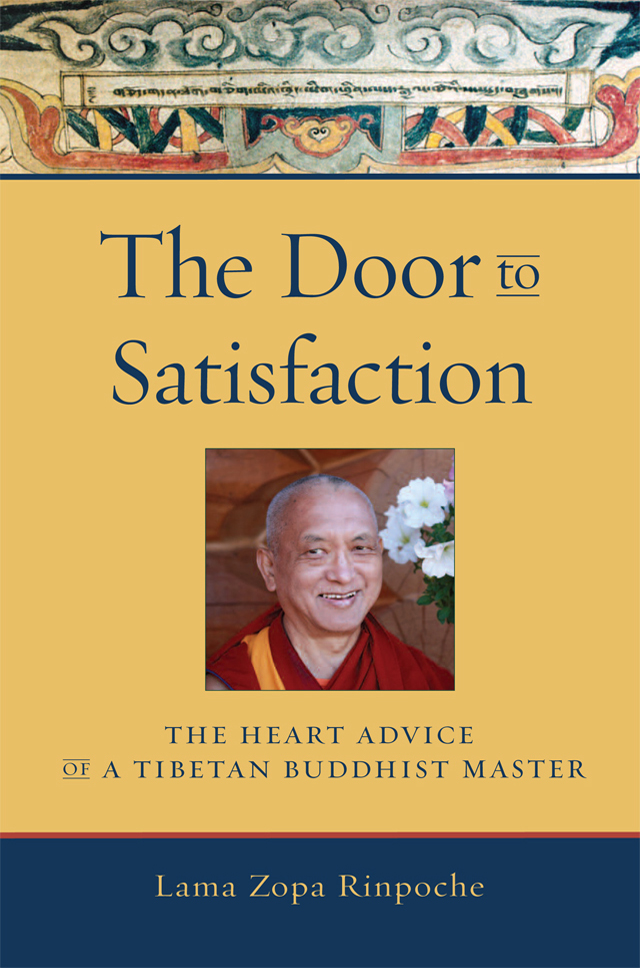 In Door to Satisfaction Lama Zopa Rinpoche reveals a text he discovered in a cave in the Himalayas that captures the essential point of Buddhist training. Rinpoche says, “Only when I read this text did I come to know what the practice of Dharma really means.”Without proper motivation, it does not matter what we do. Whether reciting prayers, meditating, or enduring great hardships, if our actions are devoid of good intention they will not become Dharma practice. Proper motivation transcends our ordinary, ephemeral desires and ultimately seeks the happiness of all living beings. “In your life,” says Rinpoche, “there is nothing to do other than to work for others, to cherish others. There is nothing more important in your life than this.”This powerful, simple message applies to Buddhists and non-Buddhists alike—we all have the power to unlock our greatest potential. Open this book and open the door to a timeless path leading to wisdom and joy. In Door to Satisfaction Lama Zopa Rinpoche reveals a text he discovered in a cave in the Himalayas that captures the essential point of Buddhist training. Rinpoche says, “Only when I read this text did I come to know what the practice of Dharma really means.”Without proper motivation, it does not matter what we do. Whether reciting prayers, meditating, or enduring great hardships, if our actions are devoid of good intention they will not become Dharma practice. Proper motivation transcends our ordinary, ephemeral desires and ultimately seeks the happiness of all living beings. “In your life,” says Rinpoche, “there is nothing to do other than to work for others, to cherish others. There is nothing more important in your life than this.”This powerful, simple message applies to Buddhists and non-Buddhists alike—we all have the power to unlock our greatest potential. Open this book and open the door to a timeless path leading to wisdom and joy.
|
|
|
Transforming Problems Into Happiness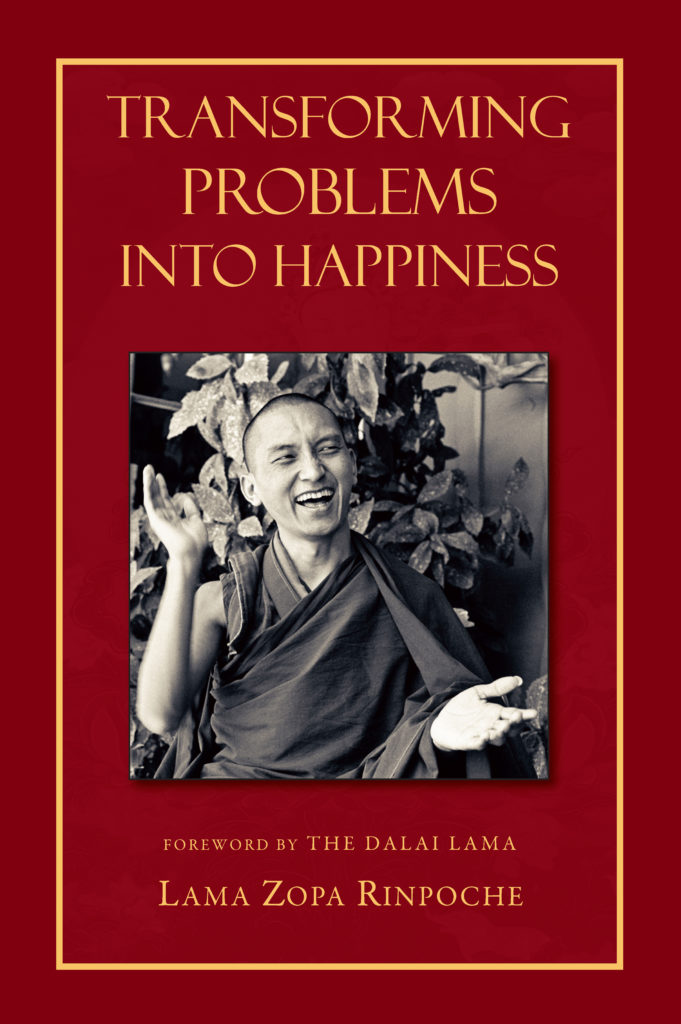 “Happiness and suffering are dependent upon your mind, upon your interpretation. They do not come from outside, from others. All of your happiness and all of your suffering are created by you, by your own mind,” says Lama Zopa Rinpoche. Commenting on an early-twentieth-century Tibetan text of instructions and practical advice for everyday spiritual living, Lama Zopa Rinpoche teaches us how to be happy during hard times by adopting skillful attitudes—ways of interpreting reality that can permit us to live a joyful and relaxed life regardless of circumstance. In Transforming Problems Into Happiness, Lama Zopa Rinpoche brings his own special flavor and contemporary relevance to a timeless teaching on Buddhist psychology. This volume will be valuable to all, no matter the spiritual background of the reader or the kind of problems that have led them to ask that ageless question: How can I achieve happiness? This new edition includes a translation of the root text, Dodrupchen Rinpoche’s (1865–1926) Instructions on Turning Happiness and Suffering into the Path of Enlightenment, translated by Tulku Thundop. Learn more about Dodrupchen Rinpoche at the Treasury of Lives. “Happiness and suffering are dependent upon your mind, upon your interpretation. They do not come from outside, from others. All of your happiness and all of your suffering are created by you, by your own mind,” says Lama Zopa Rinpoche. Commenting on an early-twentieth-century Tibetan text of instructions and practical advice for everyday spiritual living, Lama Zopa Rinpoche teaches us how to be happy during hard times by adopting skillful attitudes—ways of interpreting reality that can permit us to live a joyful and relaxed life regardless of circumstance. In Transforming Problems Into Happiness, Lama Zopa Rinpoche brings his own special flavor and contemporary relevance to a timeless teaching on Buddhist psychology. This volume will be valuable to all, no matter the spiritual background of the reader or the kind of problems that have led them to ask that ageless question: How can I achieve happiness? This new edition includes a translation of the root text, Dodrupchen Rinpoche’s (1865–1926) Instructions on Turning Happiness and Suffering into the Path of Enlightenment, translated by Tulku Thundop. Learn more about Dodrupchen Rinpoche at the Treasury of Lives.
|
|
|
How to Enjoy Death: Preparing to Meet Life’s Final Challenge without Fear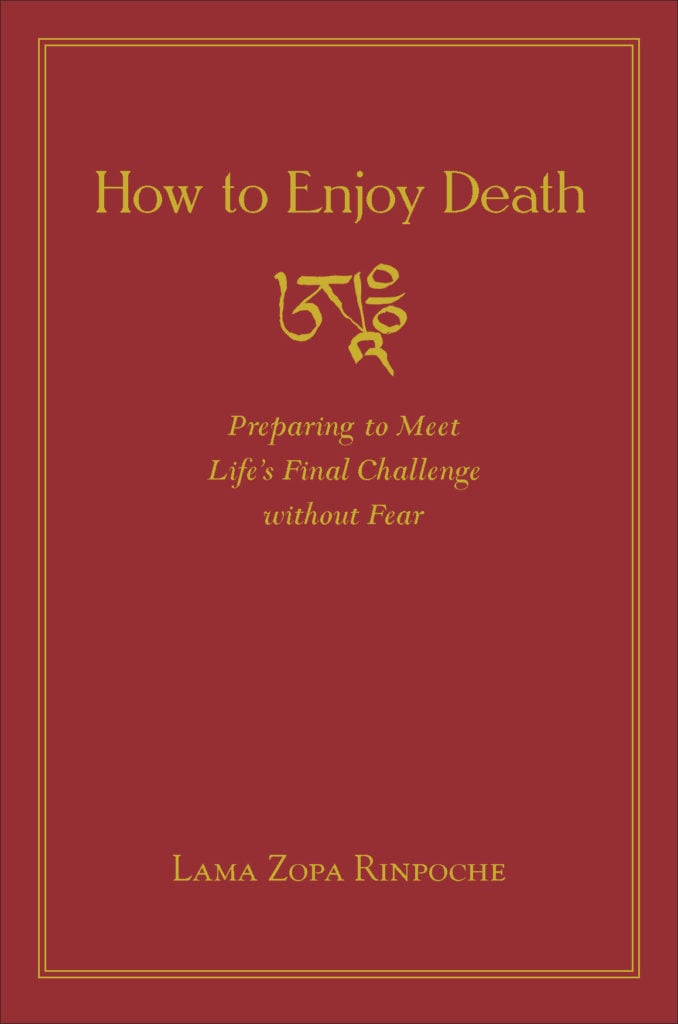 “When suddenly one day one of your loved ones dies and you don’t know what to do to help, you’ll feel so confused, so lost. This made me think that knowing how to help others at the time of death is such important education to have. By providing the right support, the right environment, you can help your loved one die peacefully, with virtuous thoughts, and thus have a good rebirth.”—Lama Zopa RinpocheFor years Lama Zopa Rinpoche has envisioned a practical book to inform students of how to help loved ones have a beneficial death. How to Enjoy Death has been compiled from years of Rinpoche’s teachings and has been lovingly edited by Venerable Robina Courtin. Here Lama Zopa Rinpoche provides detailed advice on how best to prepare ourselves to face the inevitable end of our own and our loved one’s lives with courage, grace, and a mind free of fear. With great care, Rinpoche explains what to do in the months, weeks, and days that precede death, as well as how to handle the moment itself and the mantras, prayers, and meditations that must follow the death of a loved one. All of the practices one needs to be prepared to face death are handily included between the covers of this thoroughly pragmatic volume, making this an essential reference for Tibetan Buddhist practitioners, caregivers, hospice workers, or chaplains.This limited edition book includes: “When suddenly one day one of your loved ones dies and you don’t know what to do to help, you’ll feel so confused, so lost. This made me think that knowing how to help others at the time of death is such important education to have. By providing the right support, the right environment, you can help your loved one die peacefully, with virtuous thoughts, and thus have a good rebirth.”—Lama Zopa RinpocheFor years Lama Zopa Rinpoche has envisioned a practical book to inform students of how to help loved ones have a beneficial death. How to Enjoy Death has been compiled from years of Rinpoche’s teachings and has been lovingly edited by Venerable Robina Courtin. Here Lama Zopa Rinpoche provides detailed advice on how best to prepare ourselves to face the inevitable end of our own and our loved one’s lives with courage, grace, and a mind free of fear. With great care, Rinpoche explains what to do in the months, weeks, and days that precede death, as well as how to handle the moment itself and the mantras, prayers, and meditations that must follow the death of a loved one. All of the practices one needs to be prepared to face death are handily included between the covers of this thoroughly pragmatic volume, making this an essential reference for Tibetan Buddhist practitioners, caregivers, hospice workers, or chaplains.This limited edition book includes:
|

